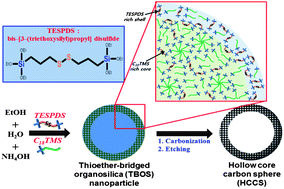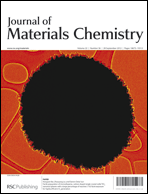A simple and reproducible sol–gel synthesis strategy was developed to fabricate hollow core carbon spheres (HCCSs) with hierarchical nanoarchitecture through the hydrolysis, self-assembly and co-condensation of bis-[3-(triethoxysilyl)propyl]disulfide (TESPDS) and octadecyltrimethoxysilane (C18TMS). This synthesis route allows one to fabricate thioether-bridged organosilica (TBOS) with tailored spherical structure and particle size which can be further converted to HCCS upon calcination under N2 flow. It is assumed that hydrophobic octadecyl chains of hydrolyzed C18TMS first form a micelle-like self-assembly structure with hydrophilic trihydroxysilyl groups as heads, and a reactive core is then expanded by the base-catalyzed co-condensation of TESPDS and/or C18TMS over the C18TMS self-assembly structure. The organic moieties of TESPDS and C18TMS not only serve as a porogen during the formation of TBOS but also as a carbon precursor for transformation of TBOS into HCCS during the carbonization. Due to its unique hierarchical nanostructure composed of hollow macroporous core and meso/microporous shell, which facilitates fast mass transport, along with large surface area for electrical charge storage, the HCCS for the first time exhibits ultrahigh specific capacitance and energy, good cycling performance and rate capability.

You have access to this article
 Please wait while we load your content...
Something went wrong. Try again?
Please wait while we load your content...
Something went wrong. Try again?


 Please wait while we load your content...
Please wait while we load your content...